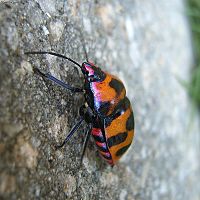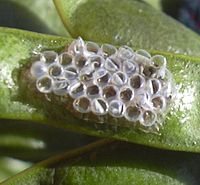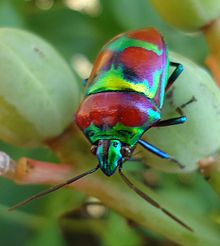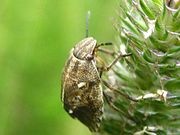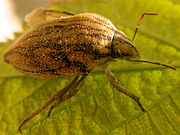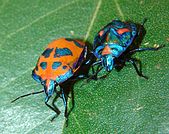- Scutelleridae
-
For jewel beetles, see Buprestidae.
Jewel bugs 
Scutiphora pedicellata, a jewel bug from Australia Scientific classification 
Kingdom: Animalia Phylum: Arthropoda Class: Insecta Order: Hemiptera Suborder: Heteroptera Infraorder: Pentatomomorpha Superfamily: Pentatomoidea Family: Scutelleridae
Leach, 1815Subfamilies - Elvisurinae
(Stål, 1872) - Eurygastrinae
Amyot & Audinet-Serville, 1843 - Hoteinae
- Odontoscelinae
Amyot & Audinet-Serville, 1843 - Odontotarsinae
(Mulsant and Rey, 1865) - Pachycorinae
Amyot & Audinet-Serville, 1843 - Scutellerinae
Leach, 1815 - Tectocorinae
McDonald & Cassis, 1984
Scutelleridae is a family of true bugs. They are commonly known as jewel bugs or metallic shield bugs due to their often brilliant coloration. They are also known as shield-backed bugs due to the enlargement of the last section of their thorax into a continuous shield over the abdomen and wings.[1] This latter characteristic distinguishes them from most other families within Heteroptera, and may lead to misidentification as a beetle rather than a bug. These insects feed on plant juices from a variety of different species, including some commercial crops. Closely related to stink bugs, they may also produce an offensive odour when disturbed. There are around 450 species worldwide.[2]
Contents
Description
Jewel bugs are small to medium-sized oval-shaped bugs with a body length averaging at 5 to 20 mm (0.20 to 0.79 in).[3] They can easily be distinguished from stink bugs (Pentatomidae) because the shield-like enlarged last section of their thorax (known as the scutellum, Latin for "little shield") completely covers the abdomen and the wings.[4]
Despite their resemblance to beetles, jewel bugs are hemipterans or true bugs.[5] The scutellum is an extension of the thorax, unlike the elytra of beetles which are hardened forewings. As such, jewel bugs have four membranous wings underneath the scutellum in contrast to two in beetles.[6] The scutellum in jewel bugs also does not have a division in the middle and thus does not 'split open' when they take flight like in beetles.[7]
The heads of jewel bugs are triangular and the antennae have three to five segments.[8] Like all heteropterans, jewel bugs are characterized by a segmented beak-like mouthpart (known as the rostrum).[2] During feeding, jewel bugs inject proteolytic enzymes in their saliva into plants, digesting plant matter into a liquid form which they then suck up.[9] The tarsus has three segments (tarsomeres).[6]
Colors
Though some species are quite drab,[10] the most conspicuous jewel bugs are often brilliantly colored, exhibiting a wide range of iridescent metallic hues that change with the view angle.[6] The colors are the result of a combination of factors. Some species like Chrsyocoris stockerus and Scutellera nobilis display colors from multiple thin layers of pigmented chitin. The colors often change or become duller when the specimens are dried, due to the topmost chitinous layer becoming opaque and obscuring the colors of the bottom layer. The colors can be restored by moistening the surfaces with water.[11][12]
Iridescence (or goniochromism) in jewel bugs like Poecilocoris lewisi are the result of structural coloration. Instead of pigments, the colors are caused by the interference, diffraction, or scattering of light by numerous tiny structures.[11]
In Poecilocoris lewisi, multiple tiny conical protuberances around 900 nm in height and averaging at a diameter of 360 nm are scattered on the epicuticle. These structures affect light passing through them, producing their oily-looking blue sheen (known as the Tyndall effect or Mie scattering).[11][12]
In other species like the African shield bug (Calidea panaethiopica), the dorsal cuticle is dotted with tiny regularly spaced hemispherical cavities. The depressions act like Bragg mirrors. When light hits the pitted surface, it gives off multiple relfections resulting in the distinctive two tone yellow-blue iridescence.[13]
The colors and patterns on jewel bugs can vary significantly between instars and even within adults of a species.[14]
Jewel bugs are also known to mimic the colors, patterns, and shape of other organisms for defensive purposes. An example is the yellow-spotted black Steganocerus multipunctatus which exhibits Müllerian mimicry with the tortoise beetle Chiridopsis suffriani.[15]
Ecology and life cycle
A cluster of the empty barrel-shaped shaped eggs of the Koa bug (Coleotichus blackburniae) from Hawaii. The 'lids' can clearly be seen.A jewel bug molting (ecdysis). The pale-colored adult is emerging from its old exoskeleton, in the foreground are two nymphs.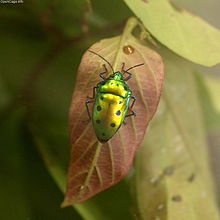 Calliphera excellens from Japan.
Calliphera excellens from Japan.
All jewel bugs feed on plants (phytophagous). The eggs are laid in compact clusters.[16] They may be round or barrel-shaped with a lid or a cap at the top (known as the operculum). They also contain a ring of small protuberances near the cap called micropylar processes. They permit the passage of sperm into the egg for fertilization and enable gaseous exchange from within the egg and the outside world for the embryos. The eggs are white or cream colored when freshly laid but can change color as the embryo matures.[17] When hatching, the prolarva (the advanced embryo) exit the egg by opening the lid through peristaltic movements and with the help of a T-shaped internal structure in the egg (known as the egg burster).[17][18]
Like all hemipterans, jewel bugs undergo incomplete metamorphosis (hemimetaboly) and do not possess larval and pupal stages. Instead the adults develop from several stages (instars) of nymphs (usually five) through successive moltings (ecdysis). Nymphs resemble the adults except for size and the absence of wings. They can be of different coloration or patterns from adults.[16]
Some species are known to exhibit parental care of eggs and nymphs. Notable examples of which are Cantao parentum,[19] Pachycoris klugii,[20] Pachycoris stalii,[21] Pachycoris torridus, and Tectocoris diophthalmus.[14][22]
Reproduction
Chemical secretions from dorsal abdominal or sternal exocrine glands are used to attract mates by certain species of jewel bugs.[23] In certain genera (like Tectocoris, Psacasta, Odontoscelis, and Irochrotus), males possess special unicellular glands in the abdomen known as the androconia (singular: androconium). They release sex pheromones when ruptured.[6]
Females possess a spermatheca, an ectodermal gland which opens into the oviduct. These serve as storage for sperm deposited by males. It contains glands which can nourish the spermatozoa until they can be released to fertilize eggs.[18]
Male jewel bugs of the genus Hotea possess an unusually large, spiky, and heavily sclerotized genitalia. They are used in a mating practice known as traumatic insemination, a result of evolutionary sexual conflict. Male Hotea bugs tear through the female reproductive ducts to deposit sperm, inflicting substantial damage to the female in the process.[24]
Defenses
Like stink bugs, a vast majority of jewel bugs, both adults and nymphs, are also capable of releasing pungent defensive chemicals from glands located on the sides of the thorax.[2][7] Typical compounds exuded by jewel bugs include alcohols, aldehydes, and esters.[25] Nymphs and adults often exhibit clustering behavior, being found in large numbers close to each other. This behavior is thought to have an evolutionary advantage. The more individuals present in an area, the stronger the odor of the chemicals released when the bugs are threatened.[19] If this fails, stink bugs will react to threat by flying away or dropping to the ground.[2]
Classification and evolution
Scutellerids were first described by the English zoologist William Elford Leach in 1815.[26][27]
Scutelleridae belongs to the order Hemiptera (true bugs), under the suborder Heteroptera and infraorder Pentatomomorpha. They are classified under the superfamily Pentatomoidea. They were formerly classified as a subfamily of Pentatomidae by George Willis Kirkaldy in 1909.[28] The earliest attempt to restore them to family status was in 1917 by Edward Payson Van Duzee.[29] Most authorities today regard it as a valid family group.[28]
The family is composed of about 81 genera and around 450 species worldwide. While the tribal and subfamilial classifications remain unclear,[24] they are divided into eight subfamilies sensu lato: Elvisurinae, Eurygastrinae, Hoteinae (sometimes classified under Pachycorinae), Odontoscelinae, Odontotarsinae, Pachycorinae, Scutellerinae, and Tectocorinae.[30]
In phylogenetic studies in 2008 by Grazia et al., Scutelleridae was shown to be consistently monophyletic, basal to Acanthosomatidae, and distal to Plataspididae and Parastrachiidae.[29][31] Below is the morphological unweighted tree of the superfamily Pentatomoidea after Grazia et al. (2008).[31]
← Urostylididae
Saileriolidae
Dinidoridae
Cydnidae sensu lato Thaumastellidae
Parastrachiinae
Corimelaenidae
Lestoniidae
Phloeidae
Scutelleridae
Plataspididae
Canopidae
Megarididae
Economic significance
Left: Eurygaster testudinaria, a sunn pest from Germany. Center: Odontotarsus grammicus, another sunn pest from Spain. Right: An adult and nymph cotton harlequin bug (Tectocoris diophthalmus).Though most jewel bugs do little harm to crop plants,[32] a few members of Scutelleridae are considered major agricultural pests. Together with some species of stink bugs, they are collectively known as sunn pests (also spelled as senn, soun, or shüne pests) or wheat bugs.[24] The most economically important species of which are members of the genus Eurygaster.
Eurygaster integriceps, in particular, is a very destructive pest of cereal crops in North Africa, the Balkans, and western and central Asia. Other scutellerids known under the name 'sunn pest' include Ventocoris fischeri and members of the genus Odontotarsus, among others.[33] Methods of control for sunn pests have included biological pest control, using wasps of the family Scelionidae from the genera Trissolcus and Ooencyrtus.[34]
The cotton harlequin bug (Tectocoris diophthalmus) is also an important pest of cotton crops and Hibiscus.[32][35]
Conservation
Biological methods of pest control have sometimes backfired. A parasitoid fly which preys on hemipterans, Trichopoda pennipes was introduced to Hawaii to control the invasive species Nezara viridula, the southern green stink bug. The fly now threatens native species of bugs in Hawaii as well, particularly the Koa bug (Coleotichus blackburniae, a jewel bug species notable for not possessing stink glands) which has now become rare.[24]
See also
 Media related to Scutelleridae at Wikimedia Commons
Media related to Scutelleridae at Wikimedia Commons  Data related to Scutelleridae at Wikispecies
Data related to Scutelleridae at WikispeciesReferences
- ^ "Scutelleridae - Jewel Bugs". Commonwealth Scientific and Industrial Research Organization (CSIRO) Entomology. http://www.ento.csiro.au/education/insects/hemiptera_families/scutelleridae.html. Retrieved April 27, 2011.
- ^ a b c d John L. Capinera (2008). Encyclopedia of entomology. Springer. pp. 608–609. ISBN 9781402062421. http://books.google.com/books?id=i9ITMiiohVQC&printsec=frontcover.
- ^ Robert G. Foottit & Peter Holdridge Adler (2009). Insect biodiversity: science and society. John Wiley and Sons. p. 247. ISBN 9781405151429. http://books.google.com/books?id=LBZHpYY2_8gC&printsec=frontcover#v=onepage&q&f=false.
- ^ Mike Picker, Charles Griffiths, and Alan Weaving (2004). Field guide to insects of South Africa. Field Guide Series. Struik. p. 132. ISBN 9781770070615. http://books.google.com/books?id=s4ke5JwbTI0C&printsec=frontcover.
- ^ Scutelleridae at National Center for Biotechnology Information (NCBI) website.
- ^ a b c d Randall T. Schuh & James Alexander Slater (1995). True bugs of the world (Hemiptera:Heteroptera): classification and natural history. Cornell University Press. ISBN 9780801420665. http://books.google.com/books?id=wmSc-2KDmZ4C&printsec=frontcover#v=onepage&q&f=false.
- ^ a b "Family Scutelleridae - Shield-backed Bugs". BugGuide. http://bugguide.net/node/view/4874. Retrieved April 27, 2011.
- ^ "Jewel bugs, Shield Backed Bugs -Family Scutelleridae". Brisbane Insects and Spiders Home Page. http://www.brisbaneinsects.com/brisbane_stinkbugs/Scutelleridae.htm. Retrieved April 27, 2011.
- ^ E. Grünbacher & B. Kromp (2008). Investigations on the occurrence of wheat bugs (Scutelleridae, Pentatomidae; Heteroptera) in organic farming of Eastern Austria. 1st Scientific Conference within the framework of the 8th European Summer Academy on Organic Farming. http://orgprints.org/15755/1/Gr%C3%BCnbacher,_E._&_Kromp,_B..pdf. Retrieved April 27, 2011.
- ^ Scott Fabricant, Mariella Herberstein & Darrell Kemp. Mechanisms and Functions of Colour in the Hibiscus Harlequin Bug. The Australasian Society for the Study of Animal Behaviour. http://www.assab.org/wp-content/uploads/ASSAB-FINAL-Programme.pdf. Retrieved April 28, 2011.
- ^ a b c Kiyoshi Minamoto & Akinori Kosaku (2002). "Cuticular Microstructures and Their Relationship to Structural Color in the Shieldbug Poecilocoris lewisi Distant". Forma (Scipress) 17 (2): 155–167. http://www.scipress.org/journals/forma/pdf/1702/17020155.pdf. Retrieved April 28, 2011.
- ^ a b Shūichi Kinoshita (2008). Structural colors in the realm of nature. World Scientific. p. 155. ISBN 9789812707833. http://books.google.com/books?id=aqj4Y4N9BZoC&printsec=frontcover#v=onepage&q&f=false.
- ^ Jean Pol Vigneron, Moussa Ouedraogo, Jean-François Colomer, and Marie Rassart (200). "Spectral sideband produced by a hemispherical concave multilayer on the African shield-bug Calidea panaethiopica (Scutelleridae)". Physical Review E (American Physical Society) 79 (2). doi:10.1103/PhysRevE.79.021907. http://pre.aps.org/abstract/PRE/v79/i2/e021907. Retrieved April 28, 2011.
- ^ a b Luis Cervantes Peredo (2002). "Description, Biology, and Maternal Care of Pachycoris klugii (Heteroptera: Scutelleridae)". Florida Entomologist (Instituto de Ecologia, Florida Center for Library Automation) 85 (3). http://www.fcla.edu/FlaEnt/fe85p464.pdf. Retrieved April 27, 2011.
- ^ Hugh D.C. Heron (2009). "Polymorphism in four tortoise beetles from Queensburgh, South Africa (Chrysomelidae: Cassidinae)". Genus (University of Wrocław) 22 (1): 133–149. http://www.biol.uni.wroc.pl/cassidae/Heron_Polymorphism.pdf. Retrieved April 28, 2011.
- ^ a b Maurice Burton & Robert Burton (1970). The international wildlife encyclopedia. 1. Marshall Cavendish. pp. 2344–2345. ISBN 9780761472667. http://books.google.com/books?id=_YicMQmIA7wC&printsec=frontcover#v=onepage&q&f=false.
- ^ a b Selami Candan, Zekiye Suludere & Dilek Durak (2005). "Ultrastructure of the Eggs Chorion of Ceraleptus obtusus (Brulle, 1839)(Heteroptera: Coreidae)". Ohio Journal of Science (The Knowledge Bank, Ohio State University) 105 (5): 138–141. doi:10.2478/s11756-007-0137-x. https://kb.osu.edu/dspace/bitstream/handle/1811/31918/V105N5_138.pdf?sequence=1. Retrieved April 27, 2011.
- ^ a b Selami Candan, Zekiye Suludere & Mahmut Erbey (2008). "Morphology of eggs and spermatheca of Odontotarsus purpureolineatus (Heteroptera, Scutelleridae)". Biologia, Bratislava (Springer) 62 (6): 763–769. doi:10.2478/s11756-007-0137-x. ISSN 0006-3088. http://www.springerlink.com/content/xg62472556535123/. Retrieved April 27, 2011.
- ^ a b "Scutelleridae: Shield-backed Bugs". Save Our Waterways Now. http://www.saveourwaterwaysnow.com.au/01_cms/details_pop.asp?ID=1161. Retrieved April 28, 2011.
- ^ James T. Costa (2006). The other insect societies. Harvard University Press. p. 281. ISBN 9780674021631. http://books.google.com/books?id=PYRFDrZs9QAC&printsec=frontcover.
- ^ Livy Williams, III, Maria C Coscarón, Pablo M Dellapé, and Timberley M Roane (2005). "The shield-backed bug, Pachycoris stallii: Description of immature stages, effect of maternal care on nymphs, and notes on life history". J Insect Sci. (University of Wisconsin Libraries) 5 (29). PMC 1615236. PMID 17119611. http://www.pubmedcentral.nih.gov/articlerender.fcgi?tool=pmcentrez&artid=1615236. Retrieved April 27, 2011.
- ^ David A. Rider. "Pentatomoid Species Known to Exhibit Parental Care". Department of Entomology, North Dakota State University. http://www.ndsu.nodak.edu/ndsu/rider/Pentatomoidea/Collection_Lists/maternal_care.htm. Retrieved April 27, 2011.
- ^ Ring T. Cardé & William J. Bell (1995). Chemical ecology of insects 2. Springer. p. 336. ISBN 9780412039614. http://books.google.com/books?id=ziv60BvPwNAC&printsec=frontcover#v=onepage&q&f=false.
- ^ a b c d Göran Arnqvist & Locke Rowe (2005). Sexual conflict. Princeton University Press. pp. 129. ISBN 9780691122182. http://books.google.com/books?id=JLfvwPqsHnMC&printsec=frontcover#v=onepage&q&f=false.
- ^ Stefan Schulz (2005). The chemistry of pheromones and other semiochemicals. Volume 2. Springer. p. 37. ISBN 9783540213086. http://books.google.com/books?id=MHza8Kvo5T8C&printsec=frontcover#v=onepage&q&f=false.
- ^ "Scutelleridae". Integrated Taxonomic Information System. http://www.itis.gov/servlet/SingleRpt/SingleRpt?search_topic=TSN&search_value=109020.
- ^ Scutelleridae Leach, 1815 at the Encyclopedia of Life
- ^ a b G. Cassis, Australia. Bureau of Flora and Fauna, & Gordon F. Gross (2002). Zoological catalogue of Australia: Hemiptera: Heteroptera (Pentatomomorpha). Csiro Publishing. p. 353. ISBN 9780643068759. http://books.google.com/books?id=UWifn5wT6D8C&printsec=frontcover#v=onepage&q&f=false.
- ^ a b Jocelia Grazia, Randall T. Schuhb, & Ward C. Wheeler (2008). "Phylogenetic relationships of family groups in Pentatomoidea based on morphology and DNA sequences (Insecta: Heteroptera)". Cladistics (Wiley-Blackwell) 24: 932–976. doi:10.1111/j.1096-0031.2008.00224.x. http://research.amnh.org/scicomp/pdfs/wheeler/Graziaetal2008.pdf. Retrieved April 27, 2011.
- ^ David A. Rider. "Classification". Department of Entomology, North Dakota State University. http://www.ndsu.nodak.edu/ndsu/rider/Pentatomoidea/Classification/classification.htm. Retrieved April 27, 2011.
- ^ a b Dimitri Forero (March 13, 2009). "Pentatomoidea". Tree of Life web project. http://tolweb.org/Pentatomoidea/10945. Retrieved April 28, 2011.
- ^ a b Murray Fletcher (2007). "Plant bugs". Primefact (NSW Department of Primary Industries) 508: 1–4. http://www.fcla.edu/FlaEnt/fe85p464.pdf. Retrieved April 27, 2011.
- ^ Randall T. Schuh & James Alexander Slater (1995). True bugs of the world (Hemiptera:Heteroptera): classification and natural history. Cornell University Press. pp. 36. ISBN 9780801420665. http://books.google.com/books?id=wmSc-2KDmZ4C&printsec=frontcover#v=onepage&q&f=false.
- ^ M. El Bouhssini, M. Abdulhai, & A. Babi (2004). "Sunn Pest (Hemiptera: Scutelleridae) Oviposition and Egg Parasitism in Syria". Pakistan Journal of Biological Sciences (Asian Network for Scientific Information) 7 (6): 934–936. ISSN 1028-8880. http://docsdrive.com/pdfs/ansinet/pjbs/2004/934-936.pdf. Retrieved April 27, 2011.
- ^ Peter T. Bailey (2007). Pests of field crops and pastures: identification and control. Csiro Publishing. pp. 97–98. ISBN 9780643067585. http://books.google.com/books?id=N10sAEHunWEC&printsec=frontcover.
External links
Categories:- Shield bugs
- Agricultural pest insects
- Elvisurinae
Wikimedia Foundation. 2010.


